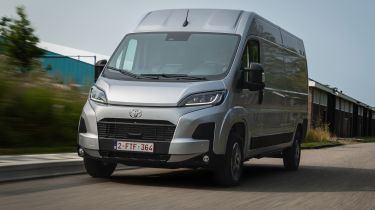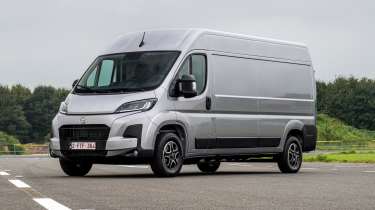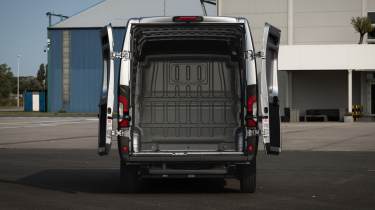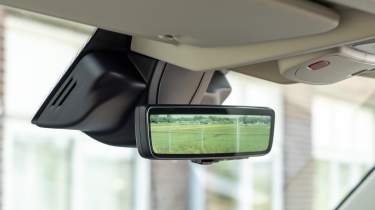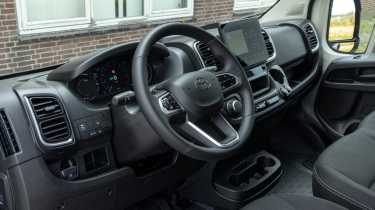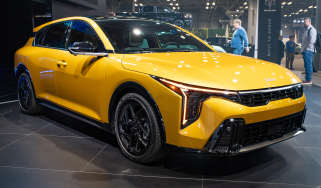Toyota Proace Max van review
The Proace Max joins Toyota’s commercial lineup with a smart look, lots of tech and an impressive warranty
About the Toyota Proace Max
The Toyota Proace Max is the latest and largest addition to the Japanese brand’s van range and another result of its partnership with the Stellantis group. Toyota said it hadn’t yet produced its own version of Stellantis’ largest van offering because it was testing the waters with the medium-sized Proace and small Proace City vans – it clearly went well then, because now the Toyota Proace Max has joined the line-up as a rebadged version of the Citroen Relay, Vauxhall Movano, Fiat Ducato and Peugeot Boxer.
There’s more to it, though, because while the aforementioned vans are all but identical, the package offered by Toyota is possibly more compelling. The brand is offering a higher entry-level specification, so there’s more kit as standard, and while that means the starting price is higher than its Stellantis cousins, Toyota reckons most buyers in the market for a van will want these additions anyway. On top of that there’s also Toyota’s competitive warranty which still applies, despite most of the running gear coming from Stellantis – Toyota carries out its own quality checks after manufacture to make sure the Proace Max adheres to its high standards.
Beauty is of course subjective, but arguably the Toyota Proace Max is the best-looking of its stablemates too. The styling isn’t too fussy, and Toyota says the smooth front end is designed for better aerodynamics and gives it a futuristic look that we think disguises what is an old yet tried-and-tested design.
Used - available now

2022 Nissan
Micra
22,169 milesManualPetrol1.0L
Cash £10,700
2015 Volvo
S60
78,200 milesManualPetrol1.6L
Cash £7,400
2016 Tesla
Model S
78,000 milesAutomaticElectric
Cash £18,999
2019 Nissan
Micra
17,450 milesAutomaticPetrol1.0L
Cash £13,199Toyota offers conversion options for those after a specialist version of the Proace Max, such as tipper and dropside configurations that can be ordered from-factory, or more bespoke versions which can be commissioned via Toyota-authorised converters, such as refrigerated vans. Should you prefer, the Proace Max can also simply be ordered as a Chassis Cab ready for your own modifications.
The Toyota Proace Max is offered in the UK with a 138bhp 2.2-litre turbocharged diesel or as a fully-electric version producing 272bhp, simply called the Proace Max Electric. The diesel can be had with a six-speed manual transmission or an eight-speed automatic.
MPG, CO2 and Running Costs
The Toyota Proace Max is offered with one engine choice, which is the 138bhp version of the Stellantis group’s 2.2-litre diesel four-cylinder engine, rather than the slightly more economical, but less powerful 120bhp version that’s available in some of its Stellantis counterparts. As a result the Proace Max diesel gets up to 36.7mpg with the six-speed manual transmission, or 33mpg with the eight-speed automatic. With the manual gearbox, CO2 emissions range from between 204-238g/km, while the automatic emits slightly more from 226-238g/km.
The Toyota Proace Max is also available as a fully electric model which has an official range of 260 miles. That’s one of the most impressive range figures in the class, on par with models like the Fiat E-Ducato and Peugeot E-Boxer with which it shares its underpinnings, and further than the Ford E-Transit which has a maximum range of 249 miles. This figure will differ in the real world depending on the load and weight of the vehicle when transporting goods, so if you’ll be carrying particularly heavy loads over long distances it might not be worth going for the EV.
Load Space and Practicality
The height and length options of the Toyota Proace Max aren’t quite as extensive as those offered by the Fiat, Peugeot, Vauxhall and Citroen versions, with Toyota having streamlined them with a view to expanding the choice in the future if there’s the demand.
The Toyota Proace Max can be had in four sizes, but unlike in the rest of Europe there’s no H1 low roof option. There are two heights available, H2 (2,524mm) and H3 (2,764mm) and three lengths: L2 (5,413mm), L3 (5,998mm) and L4 (6,363mm). L2 is only available with the diesel and H2 combination, while L4 and H3 can only be specified with the electric motor. Both the H2 and H3 lengths can be had on L3 models with a diesel or electric powertrain. These combinations provide a cargo area of between 12-17 cubic metres and the capacity to carry up to five Euro pallets.
The Proace Max diesel can carry a payload weight of up to 1,400kg, while the Electric version is actually capable of carrying a heavier 1,460kg – just be aware that this will have a detrimental effect on driving range. The diesel is marginally more capable when it comes to towing capacity and can pull up to 2,500kg, while the Electric can tow 2,400kg.
The rear doors open up to 270 degrees, which is useful for getting them out of the way to load up the rear without obstruction, and there’s a sliding side door. Accessories such as a roof platform and rear ladder can be specified, as well as racking and shelving options. A plywood interior lining comes as standard but can be deleted according to preference, knocking around £200 off the Proace Max’s price.
Aside from the standard panel vans, there are also factory-built tipper and dropside models, plus conversion options that can be ordered direct from local Toyota-authorised converters which the brand is still building a network of. These include options such as box vans or refrigerated vans, and part of the brand’s authorisation process ensures the work will be carried out to Toyota’s high standards.
If preferred, you can also purchase the Proace Max as a chassis cab or platform cabin, the latter of which comes without a bulkhead, making it the ideal choice for minibus or campervan conversions.
Reliability and safety
The Toyota Proace Max is built on a well tried-and-tested platform used by its Stellantis relatives. Those vans have built up a good reputation for reliability over the years, so the Proace Max should also be dependable. For added peace of mind, Toyota also carries out its own quality checks after manufacture to make sure the van meets its high standards. As a result, the Proace Max – as with Toyota’s other vans and cars – gets a competitive 10 year/100,000-mile warranty, so long as it’s serviced every year or every 10,000 miles by an official Toyota dealer. Also included with the purchase of any Toyota commercial van is five years’ free roadside assistance. If you do have any issues with your van while it’s under warranty, Toyota will provide you with a courtesy van to keep your business mobile while your own one is repaired.
There’s lots of safety assistance tech included on the Toyota Proace Max. This includes a Moving Off Information System and Blind Spot Information System which monitors the perimeter of the van and warns the driver of any potential hazards. An alert will flash and sound in the driver’s binnacle and on the door mirrors if a pedestrian, cyclist or motorbike is detected.
There’s also a Crosswind Assist system which stabilises the vehicle when driving through strong crosswinds by applying gentle braking force to keep the Proace Max in lane. In the event of an accident the vehicle’s computer will record and collect telemetry information from before, during and after an impact.
Driving and Performance
Despite the large size of the Proace Max it doesn’t feel as daunting to drive as you might expect – in fact, it feels surprisingly car-like and there’s just enough feeling through the steering wheel and chassis to place where the wheels are at all times.
Unsurprisingly for a van of this type the driving position is high, but it’s easy to get used to and gives a great view of the road ahead. It’s easy to see around you with the big, well-positioned convex wing mirrors and the rear-view camera in place of the centre mirror. Because there’s no rear window, that camera comes in handy while driving, even if it doesn’t quite offer the same sense of distance while manoeuvring in tight spaces – happily, the Proace Max also gets parking sensors to warn you if you’re about to hit something while reversing.
The first version we tested was the 2.2-litre diesel with the six-speed manual transmission. Perhaps due to the weight of the Proace Max, it requires quite a bit of gas to set off smoothly which can make it feel quite noisy and unrefined to drive. The gearing is quite short so you’ll find you have to change up and down quite a lot in urban areas which can quickly become tedious, especially if you’ll have to do lots of driving in these environments.
The eight-speed automatic changes the driving experience completely – it’s quick to respond and change gear accordingly, meaning you can spend more time focusing on the road. At no point did it feel as though the Proace Max’s auto gearbox was holding onto the gears for too long or short. If you want to override the system yourself you can do so via the paddle shifters on the back of the steering wheel which are very responsive to your inputs.
The Proace Max Electric’s powertrain is the most refined of the three and is incredibly quiet and smooth. As a result, it was the easiest to drive and definitely worth considering if you’re looking to make the switch to a zero emissions van and you think its capability fits the needs of your business. The Proace Max even comes with a drive mode selector which might seem out of place in a commercial van, but the difference between Power, Normal and Eco is quite striking, so it’s worth fiddling with this to best suit your driving style.
While the Proace Max Electric’s official power figure is 268bhp, the full output is only available in the Power mode, where as it’s restricted to 215bhp in Normal mode and 161bhp in Eco. Acceleration felt much more brisk in Power and we found it came in useful putting the van into this mode when overtaking on the motorway.
The regenerative braking technology is a useful feature that harvests energy that would otherwise be lost from braking and puts it back into the battery. There are three levels of regenerative braking available and these can be adjusted via the paddles on the back of the steering wheel
When driving the Proace Max without a load on board it can feel rather bouncy, but it never feels uncontrolled or wallowy. The ride quality was comfortable for the most part but we found that bigger ridges and bumps in the road made the whole van shake quite considerably.
It comes with a Crosswind Assist feature which is a system that helps to counter the impact of blustery weather on this large, tall van. The weather on our test day in the Netherlands was very rainy and windy at one point and while we could still feel it battering the sides of the Proace Max, it felt steady and composed throughout. One gripe was how long the automatic wipers took to react to the sudden onset of heavy rain and we found we had to manually activate them, despite the auto system being active.
Cab and Interior
The Proace Max’s interior is perfectly pleasant for a commercial van in terms of fit and finish, although we had some qualms about the seating position. As with its Stellantis stablemates, the Proace Max’s cab is pushed right the way forward to prioritise cargo – unfortunately that means legroom is a bit tight. While the second and third occupants might not find this too bad to deal with, it does mean the pedals are set very close to the driver, even when the driver’s seat is positioned right back. The gear lever in the manual model sits very close to the steering wheel on the dash, too, which can take some getting used to. Despite being a smaller van, the medium-sized Proace’s cabin feels much more spacious.
One thing we particularly like about the cabin of the Toyota Proace Max is the sheer amount of storage space available. The tall doors have large cupholders and bins big enough for some tools, clipboards or other items, while there’s a large bin ahead of the passengers on the dash and the three seats can be flipped open revealing even more space underneath.
Toyota has opted to keep the Proace Max line-up simpler and of a higher spec than the Fiat, Vauxhall, Peugeot and Citroen offerings because the Japanese brand reckons UK buyers will want the extra kit anyway. As such, the sole Icon trim comes with a 10-inch infotainment screen as standard which feels crisp, clear and responsive to use – this is a larger, more modern system than the one offered in the mid-size Proace. The inbuilt sat-nav feels easy to use and follow, but if you prefer to use wireless Apple CarPlay or Android Auto the system features this as standard too. The crosswind assist tech, traffic-jam assist, blind-spot monitoring and moving off system all come as standard. The Proace Max Electric gets a seven-inch driver’s display – it works well for the most part, but we don’t like the fact that the tachometer is displayed with light-up segments rather than a moving needle because it can lag slightly and doesn’t show the revs precisely enough.
Van dimensions
| Body style | Height | Width | Length |
| L2H2 (diesel) van | 2,524mm | 2,050mm | 5,413mm |
| L3H2 (diesel/EV) van | 2,524mm | 2,050mm | 5,998mm |
| L3H3 (diesel/EV) van | 2,764mm | 2,050mm | 5,998mm |
| L4H3 (EV) van | 2,764mm | 2,050mm | 6,363mm |
Load area dimensions
| Body style | Height | Width | Length | Volume |
| L2H2 (diesel) van | 1,932mm | 1,870mm | 3,120mm | 12m3 |
| L3H2 (diesel/EV) van | 1,932mm | 1,870mm | 3,705mm | 13m3 |
| L3H3 (diesel/EV) van | 2,172mm | 1,870mm | 3,705mm | 15m3 |
| L4H3 (EV) van | 2,172mm | 1,870mm | 4,070mm | 17m3 |
